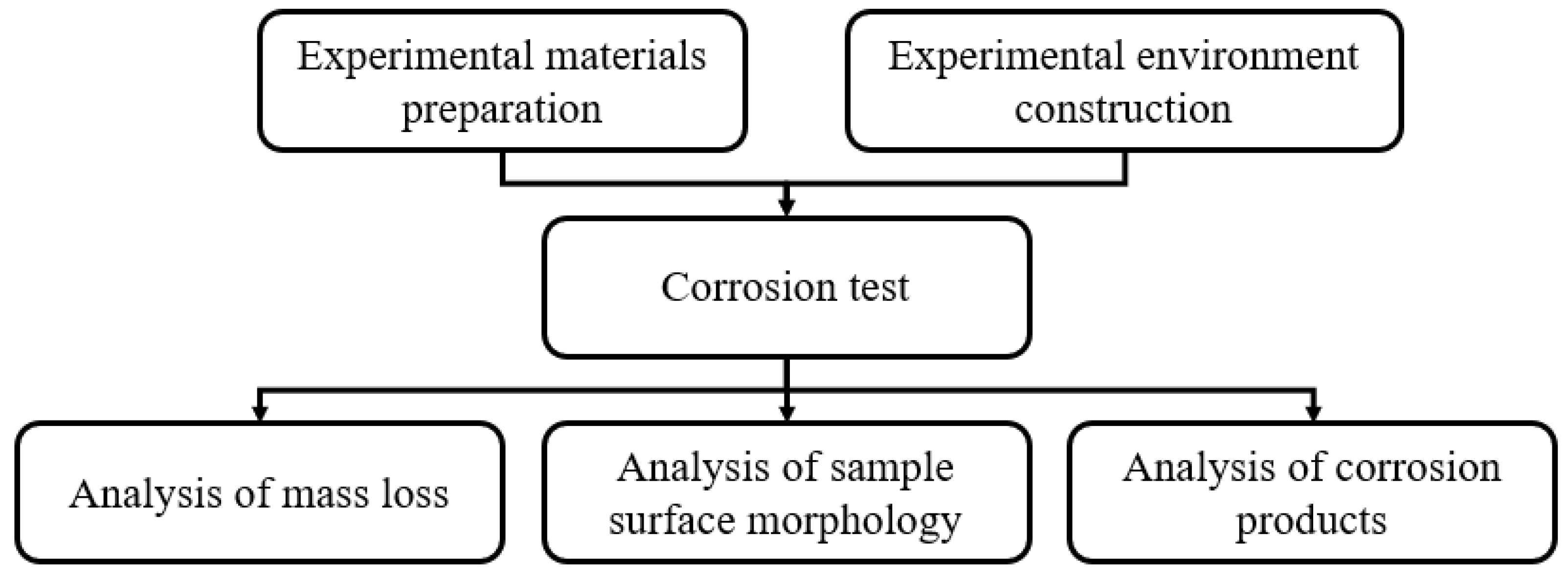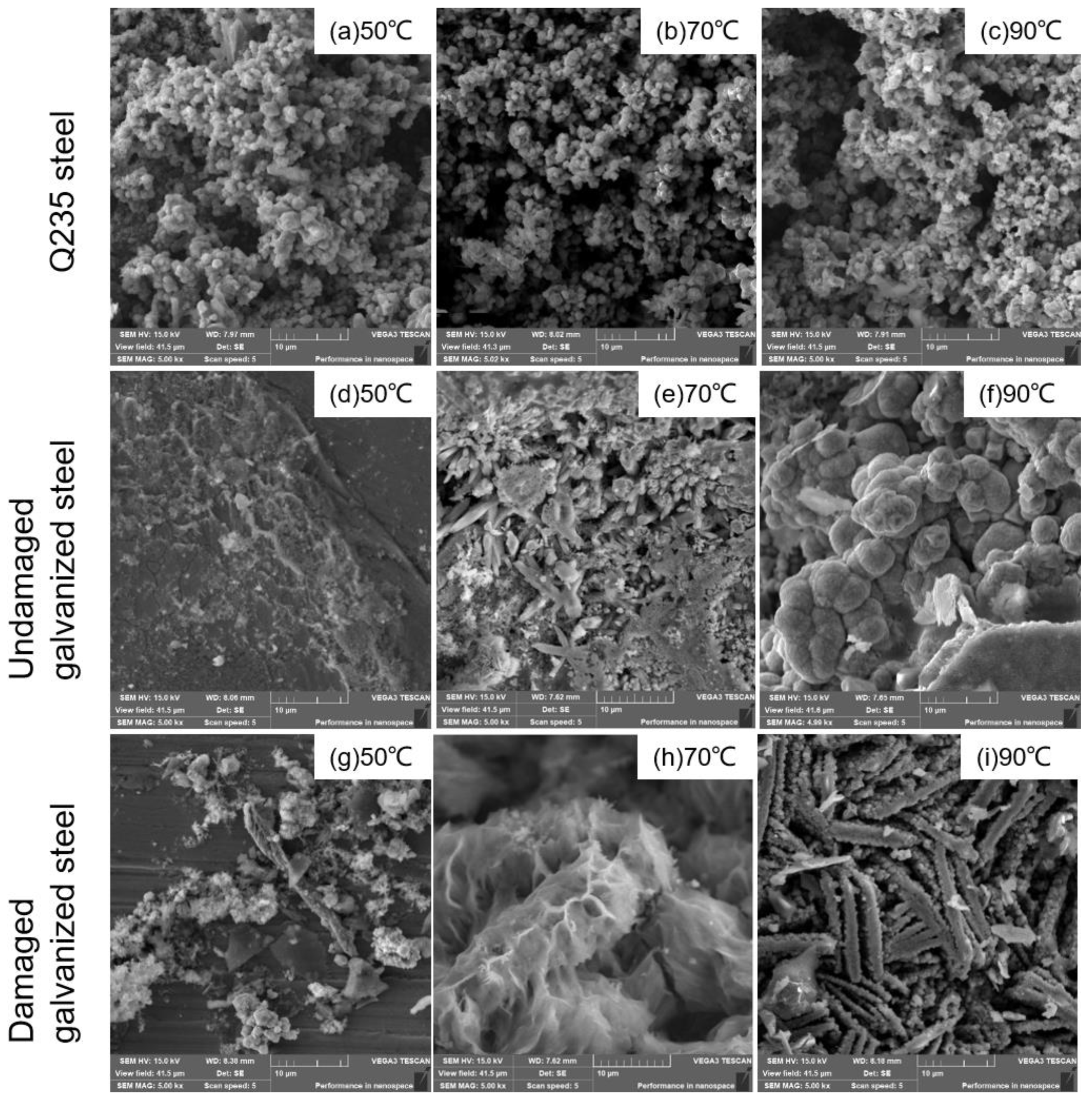Effects of Ambient Temperature and State of Galvanized Layer on Corrosion of Galvanized Steel in High-Humidity Neutral Atmosphere
Abstract
:1. Introduction
2. Materials and Methods
2.1. Experimental Materials
2.2. Corrosion Test
2.3. Mass Loss Analysis
2.4. Analysis of Specimen Surface Morphology and Corrosion Products
3. Results and Discussion
3.1. Atmospheric Corrosion Kinetics of Galvanized Steel
3.2. Chemical Analysis of Corrosion Products
- Generally speaking, the atmospheric corrosion behavior of carbon steel-like metal materials is often closely related to temperature, humidity, and the atmospheric environment. At the beginning of corrosion, the surface of the galvanized layer often forms a water film due to humidity, which leads to the formation of Zn(OH)2 on the surface, causing a decrease in PH, which combines with CO2, SO2, and other gases present in the air to form a new oxide. For example, combine with CO2 to form Zn5(OH)6(CO3)2, etc., and combine with SO2 to form Zn4(OH)6SO4. The oxide formed in turn reduces the contact between the base metal and the corrosive environment, thus inhibiting the occurrence of corrosion. However, in the simulated environment of this study, on the one hand, the ambient humidity was high and the surface of the galvanized layer was prone to form a liquid film; on the other hand, the ambient temperature was high and SO2, CO2, and Cl- were present in the air.
- The specimens of each type on the 60th day of the test were selected for chemical analysis of corrosion products. Since the corrosion products of damaged and undamaged galvanized steel were extremely small at 50 °C, no specimens were taken for these two types of specimens. Figure 6 shows the XRD physical phase analysis of the surface corrosion products of the three types of specimens after corrosion at different temperatures. It can be seen that the composition of the surface corrosion products of galvanized steel was slightly different at different temperatures, especially for galvanized steel as a material. At 70 °C, the peak intensities of ZnO and Zn(OH)2 in the corrosion products of undamaged galvanized steel are relatively high, and there are also lower peak intensities of Zn5(OH)6(CO3)2 and Zn4(OH)6SO4 xH2O. However, at 90 °C, the peak intensity of ZnO in the corrosion products drops sharply, while that of Fe3O4 increases significantly. Based on this phenomenon, we conclude that at 90 °C, the base metal of galvanized steel is already undergoing corrosion. For damaged galvanized steel, there are oxidation products of both iron and zinc due to the destruction of the galvanized layer. Its corrosion products were mainly Fe3O4, ZnO, and Zn(OH)2, accompanied by Zn4(OH)6SO4 xH2O and Zn5(OH)6(CO3)2. As the temperature increased, the intensity of the peaks corresponding to the corrosion products ZnO and Zn(OH)2 gradually became more and more obvious, indicating that the increase in temperature also caused the zinc in other undamaged regions to participate more actively in the oxidation reaction. The corrosion products of Q235 steel were mainly Fe3O4, αFeOOH, βFeOOH, and γFeOOH, and their peak intensity increased to varying degrees with the increase in temperature.
3.3. Analysis of Rust Layer Morphology
3.3.1. Macroscopic Morphology
3.3.2. Microscopic Morphology
3.4. Discussion
4. Conclusions
- (1)
- In a neutral atmospheric environment with high humidity at 50 °C, the zinc layer of damaged galvanized steel can still effectively slow down the corrosion rate of the base metal. However, when the temperature rises to 70 °C and 90 °C, the damage to the galvanized layer will accelerate the corrosion of the base metal.
- (2)
- In a neutral atmosphere with high humidity, the corrosion rate of galvanized steel will be significantly increased from 50 °C to 70 °C without changing the morphology or composition of its corrosion products. On the contrary, the effect on the corrosion rate of galvanized steel from 70 °C to 90 °C is not obvious, but the morphology and composition of its corrosion products change greatly.
Author Contributions
Funding
Institutional Review Board Statement
Informed Consent Statement
Data Availability Statement
Acknowledgments
Conflicts of Interest
References
- Guttman, H. Effects of Atmospheric Factors on the Corrosion of Rolled Zinc; ASTM International: Oakville, ON, Canada, 1968; pp. 223–239. [Google Scholar] [CrossRef]
- Odnevall, I.; Leygraf, C. Formation of NaZn4Cl (OH)6SO4 6H2O in a marine atmosphere. Corros. Sci. 1993, 34, 1213–1229. [Google Scholar] [CrossRef]
- Persson, D.; Thierry, D.; Karlsson, O. Corrosion and corrosion products of hot dipped galvanized steel during long term atmospheric exposure at different sites world-wide. Corros. Sci. 2017, 126, 152–165. [Google Scholar] [CrossRef]
- Del Angel, E.; Vera, R.; Corvo, F. Atmospheric corrosion of galvanised steel in different environments in Chile and Mexico. Int. J. Electrochem. Sci. 2015, 10, 7985–8004. [Google Scholar]
- Sabir, S.; Ibrahim, A.A. Influence of atmospheric pollution on corrosion of materials in Saudi Arabia. Corros. Eng. Sci. Technol. 2017, 52, 276–282. [Google Scholar] [CrossRef]
- Saricimen, H.; Ahmad, A.; Quddus, A.; Aksakal, A.; Ul-Hamid, A.; Siddique, T.A. Corrosion of bare and galvanized mild steel in arabian gulf environment. J. Mater. Eng. Perform. 2010, 19, 984–994. [Google Scholar] [CrossRef]
- Zheng, X.W.; Gong, M. Atmospheric corrosion behavior of carbon steel and galvanized steel in Southwest China. Mater. Test. 2018, 60, 619–626. [Google Scholar] [CrossRef]
- Gu, T.; Liu, Y.; Peng, C.; Zhang, P.; Wang, Z. Initial atmospheric corrosion of zinc-aluminum-magnesium coated steel and galvanized steel in regions of extremely cold and industrial climate. Mater. Chem. Phys. 2022, 291, 126686. [Google Scholar] [CrossRef]
- Zhang, D.; Wang, Z.; Zhou, Y.; Liu, Y.; Yin, Q.; Cao, G. Study on the initial corrosion behavior of galvanized steel in the atmospheric environment of Qinghai Salt Lake. Chin. J. Mater. Res. 2018, 32, 255–262. [Google Scholar]
- Johansson, E.; Gullman, J. Corrosion study of carbon steel and zinc-comparison between field exposure and accelerated tests. In Atmospheric Corrosion; ASTM International: West Conshohocken, PA, USA, 1995. [Google Scholar]
- Qiao, C.; Shen, L.; Hao, L.; Mu, X.; Dong, J.; Ke, W.; Liu, J.; Liu, B. Corrosion kinetics and patina evolution of galvanized steel in a simulated coastal-industrial atmosphere. J. Mater. Sci. Technol. 2019, 35, 2345–2356. [Google Scholar] [CrossRef]
- Wang, J.; Huang, Q.; Liu, J.; Zhang, Y.; Qiao, C.; Hao, L.; Dong, J.; Ke, W. Research on indoor accelerated corrosion of galvanized steel in simulated atmospheric environment in Guangzhou area. Chin. J. Mater. Res. 2018, 32, 631–640. [Google Scholar]
- Spence, J.W.; Haynie, F.H.; Lipfert, F.W.; Cramer, S.D.; McDonald, L.G. Atmospheric corrosion model for galvanized steel structures. Corrosion 1992, 48, 1009–1019. [Google Scholar] [CrossRef]
- Spence, J.W.; McHenry, J.N. Development of regional corrosion maps for galvanized steel by linking the RADM engineering model with an atmospheric corrosion model. Atmos. Environ. 1994, 28, 3033–3046. [Google Scholar] [CrossRef]
- Dubuisson, E.; Szunerits, S.; Caire, J.P.; Lavie, P.; Cordier, S. Use of experimental design to empirically model atmospheric corrosion of galvanised steel. J. Appl. Electrochem. 2008, 38, 321–327. [Google Scholar] [CrossRef]
- Benarie, M.; Lipfert, F.L. A general corrosion function in terms of atmospheric pollutant concentrations and rain pH. Atmos. Environ. (1967) 1986, 20, 1947–1958. [Google Scholar] [CrossRef]
- Legault, R.A.; Preban, A.G. Kinetics of the atmospheric corrosion of low-alloy steels in an industrial environment. Corrosion 1975, 31, 117–122. [Google Scholar] [CrossRef]
- Li, D.L.; Fu, G.Q.; Zhu, M.Y. Corrosion characteristics of low carbon steel in hot and humid industrial marine atmosphere. Chin. J. Eng. 2017, 39, 739–746. [Google Scholar] [CrossRef]
- ISO 6892-1; Metallic Materials-Tensile Testing-Part 1: Method of Test at Room Temperature, 3rd ed. ISO Copyright Office: Geneva, Switzerland, 2019; pp. 40–42.
- ISO 1460; Metallic Coatings-Hot Dip Galvanized Coating on Ferrous Materials-Gravimetric Determination of the Mass per Unit Area, 2nd ed. ISO Copyright Office: Geneva, Switzerland, 1992; pp. 1–2.
- ISO 1461; Hot Dip Galvanized Coatings on Fabricated Iron and Steel Articles-Specifications and Test Methods, 3rd ed. ISO Copyright Office: Geneva, Switzerland, 2009; pp. 5–7.
- Liu, S.; Sun, H.Y.; Sun, L.J. Effects of pH value and temperature on electrochemical corrosion behavior of galvanized steel in simulated rust solution. J. Funct. Mater. 2013, 44, 858–861+865. [Google Scholar]
- Li, X.M.; Chen, D.H.; Chen, J.W.; Long, H.P.; Zhou, J.L. Influence of temperature in simulated acid rain solution on corrosion behavior of galvanized steel wire of bridge cables. Corros. Sci. Prot. Technol. 2010, 22, 14–17. [Google Scholar]
- Legault, R.A.; Pearson, V.P. Atmospheric corrosion in marine environments. Corrosion 1978, 34, 433–437. [Google Scholar] [CrossRef]
- ISO 8407; Corrosion of Metals and Alloys-Removal of Corrosion Products from Corrosion Test Specimens, 2nd ed. ISO Copyright Office: Geneva, Switzerland, 2009; pp. 5–8.
- Askey, A.; Lyon, S.; Thompson, G.; Johnson, J.; Wood, G.; Sage, P.; Cooke, M. The effect of fly-ash particulates on the atmospheric corrosion of zinc and mild steel. Corros. Sci. 1993, 34, 1055–1081. [Google Scholar] [CrossRef]
- Graedel, T.E. Corrosion Mechanisms for Zinc Exposed to the Atmosphere. J. Electrochem. Soc. 1989, 136, 193C. [Google Scholar] [CrossRef]
- Friel, J.J. Atmospheric Corrosion Products on Al, Zn, and AlZn Metallic Coatings. Corrosion 1986, 42, 422–426. [Google Scholar] [CrossRef]
- Grauer, R. Feste Korrosionsprodukte—I Magnesium, Zink, Cadmium, Blei und Kupfer. Mater. Corros. 1980, 31, 837–850. [Google Scholar] [CrossRef]
- Biestek, T.; Drys, M.; Sokolov, N.; Knotkova, D.; Ramishvili, R.; Kozhukharov, V.; Zeidel, M. Atmospheric corrosion of metallic systems. V. Identification of the chemical compounds in the corrosion products of zinc. Prot. Met. 1984, 19, 612–615. [Google Scholar]
- Almeida, E.; Morcillo, M.; Rosales, B. Atmospheric corrosion of zinc Part 1: Rural and urban atmospheres. Br. Corros. J. 2000, 35, 284–288. [Google Scholar] [CrossRef]








| 50 °C | 70 °C | 90 °C | |
|---|---|---|---|
| Q235 steel | 1; (Fe3O4); Loose | 1.83; (Fe3O4); Loose | 7.09; (Fe3O4); Loose |
| Undamaged galvanized steel | 0.07; (×); × | 1.24; (ZnO); Dense | 4.69; (Fe3O4, ZnO); Loose. |
| Damaged galvanized steel | 0.66; (×); × | 3.10; (Fe3O4, ZnO); Dense | 8.90; (Fe3O4, ZnO); Loose |
Disclaimer/Publisher’s Note: The statements, opinions and data contained in all publications are solely those of the individual author(s) and contributor(s) and not of MDPI and/or the editor(s). MDPI and/or the editor(s) disclaim responsibility for any injury to people or property resulting from any ideas, methods, instructions or products referred to in the content. |
© 2023 by the authors. Licensee MDPI, Basel, Switzerland. This article is an open access article distributed under the terms and conditions of the Creative Commons Attribution (CC BY) license (https://creativecommons.org/licenses/by/4.0/).
Share and Cite
Liang, Y.; He, B.; Fu, G.; Wu, S.; Fan, B. Effects of Ambient Temperature and State of Galvanized Layer on Corrosion of Galvanized Steel in High-Humidity Neutral Atmosphere. Materials 2023, 16, 3656. https://doi.org/10.3390/ma16103656
Liang Y, He B, Fu G, Wu S, Fan B. Effects of Ambient Temperature and State of Galvanized Layer on Corrosion of Galvanized Steel in High-Humidity Neutral Atmosphere. Materials. 2023; 16(10):3656. https://doi.org/10.3390/ma16103656
Chicago/Turabian StyleLiang, Yusong, Bin He, Guo Fu, Shoujun Wu, and Bin Fan. 2023. "Effects of Ambient Temperature and State of Galvanized Layer on Corrosion of Galvanized Steel in High-Humidity Neutral Atmosphere" Materials 16, no. 10: 3656. https://doi.org/10.3390/ma16103656
APA StyleLiang, Y., He, B., Fu, G., Wu, S., & Fan, B. (2023). Effects of Ambient Temperature and State of Galvanized Layer on Corrosion of Galvanized Steel in High-Humidity Neutral Atmosphere. Materials, 16(10), 3656. https://doi.org/10.3390/ma16103656




